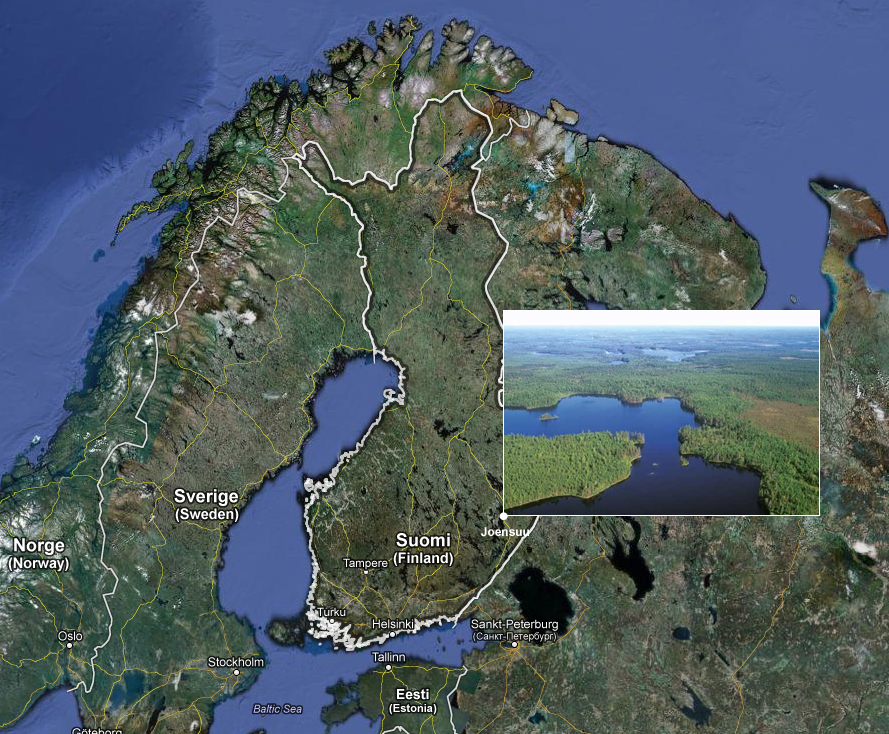General information about the case study
The northern boreal case study area is located in the Provence of North-Karelia at the border to Russia. The area represents the mid-boreal forest landscape in the central part of Finland (62o N) (Figure 1). The forests in the case study area are privately owned, and they are regularly managed mainly for timber production. Population density in the area is low (< 10 persons per km2).
Current climate, climate change and site fertility
The current climate (1960 -2000) used in the study was that for the Joensuu airport (N 62o 40’, E 29o 38’, asl 94 m) close to the study area. Under changing climate, CO2 is expected to increase from 363 ppm to 635 ppm until 2100. Corresponding increase in annual mean temperature will be from 2 to 6 oC; in summer temperature (June, July, August) from 14 to 17 oC. At the same time, the annual precipitation is expected to increase from 500 mm to 550 mm, the main increase occurring outside the growing season (June, July, August) (Figure 2).
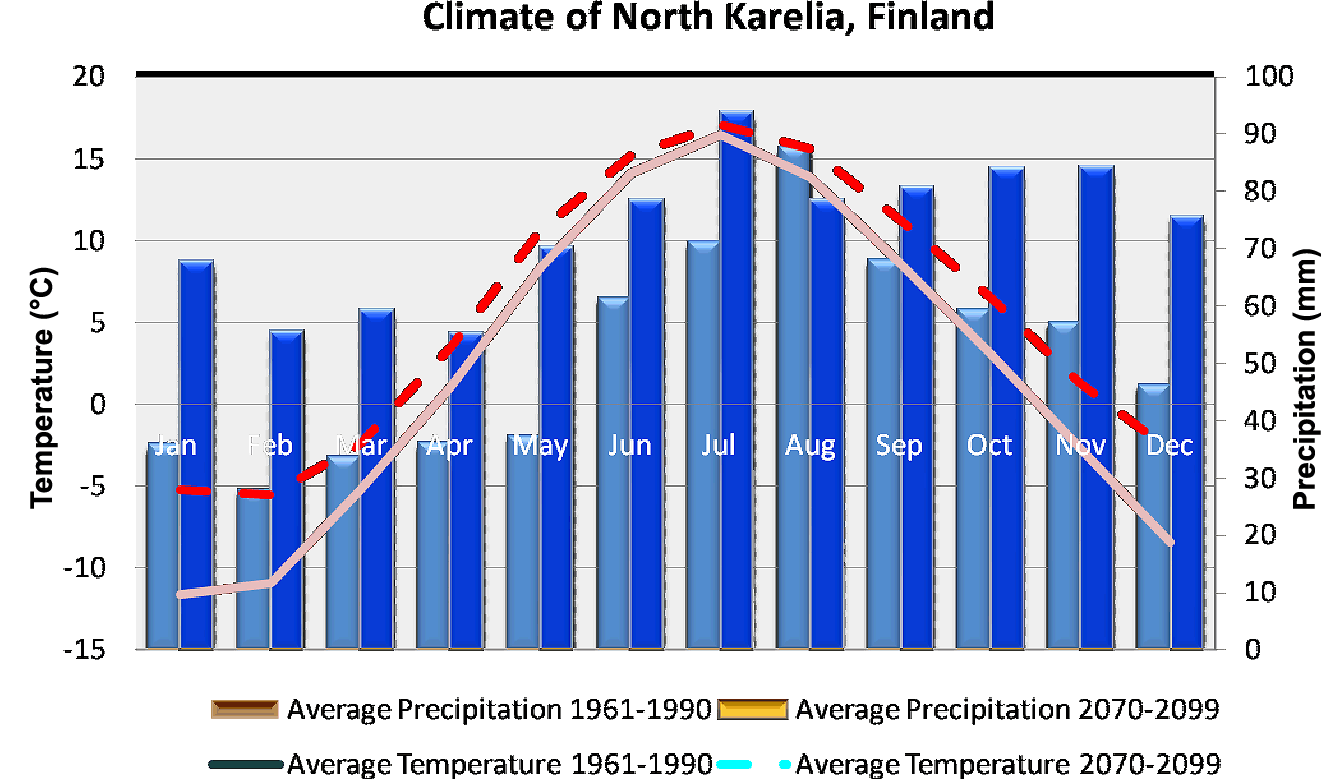
Figure 2. Monthly distribution of temperature and precipitation currently (1961 – 1990, CUR) and under the changing climate (CC, 2070 – 2099 Motive A1B scenario) in the northern boreal case study area.
Forests
The total land area in the case study is 1520 ha, of which 950 ha is forested. The rest are small fields, lakes and roads etc. Forest land is dominated by even-aged stands of Scots pine (Pinus sylvestris), Norway spruce (Picea abies) and birch (B. pendula and B. pubescens). A part of the forest land (44%) is of low fertility (Calluna (CT) and Vaccinium (VT)) occupied by Scots pine, whereas 32% of land is of medium fertility (Myrtillus type, MT) occupied by mono-species stands or in mixtures. The rest (24%) of the land is of high fertility (Oxalis–Myrtillus type, OMT) occupied mainly by Norway spruce and birch pure or in mixtures. The productive forest land (the annual mean growth potential ≥ 1 m3 ha-1 yr-1) is distributed in 650 separate stands (Figure 3 and 4). The age class distribution is fairly even across the whole area, representing 25% in the age class 1-19 yr, 39.4% in the class 20-59, 19.5% in the class 60–99 and 16.1% in the class with the age > 100 yr. The total stocking of stem wood over the whole area is 233 500 m3, representing mainly Scots pine (53%) and Norway spruce (31%). The share of birch is 16%.
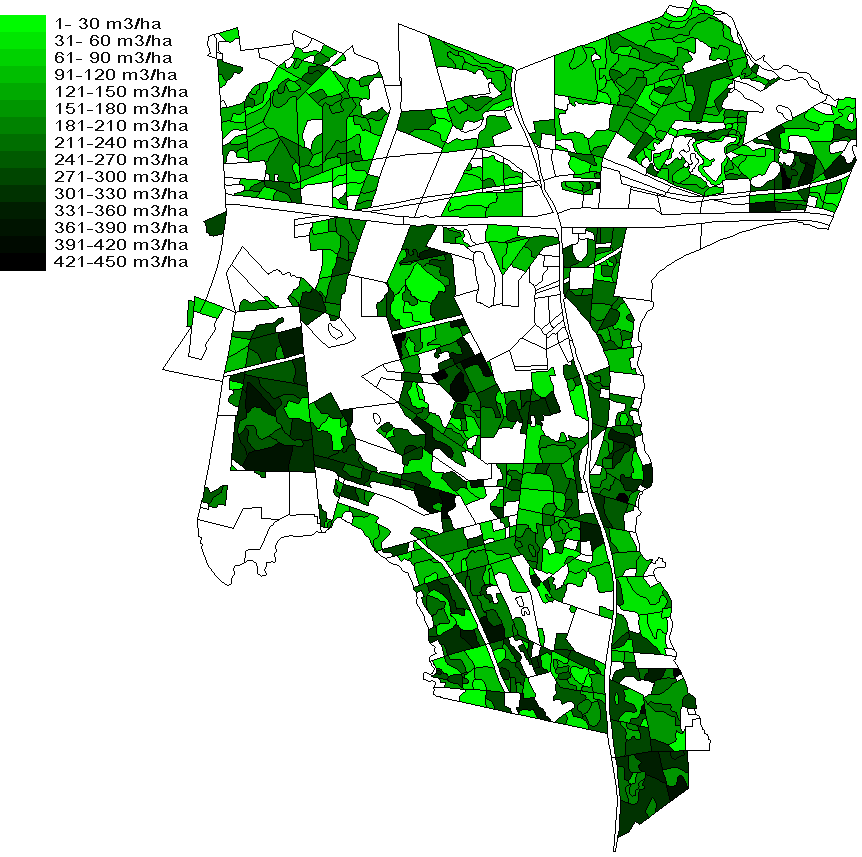
Figure 4. Map of forests in the case study area showing the separate stands with the stocking of stem wood.
Stakeholders, forest goods and services and governance
The forests in the case study area are traditionally used for timber production. This is still the main use, but the production of energy biomass is increasing in the form of harvesting logging residues, including stumps. This is why the forest owners are the main stakeholders in the area. Each forest owner is a self-governing decision-maker, who controls the management in the area owned by her/him. In this regard, they have support from the Finnish Forest Centre (North Karelia regional unit), which is an advisory and regulatory body regarding the forestry and management of forest environment. Further support is given by the forestry experts of the Regional Forest Management Association of Pohjois-Karjala, which has a major role in providing support and guidelines for forest owners in regard to management, timber trade, forest planning and implementation of practical forest management. Nature Conservation Association and Hunting Association are also interested in the management and use of forests in the case study area, but they have no legal right to control the management in the area. However, they may lobby how forests should be management. In this regard, the landscape amenity, recreation, including collecting mushrooms and berries, and hunting are important issues. The access in the area is free for public, but the hunting rights belong only to forest owners.
Are tree species in forest sensitive to climate change?
Growth
All the tree species in the case study area will physiologically (e.g. net primary production, NPP) benefit from warmer climate during the next 30 years as shown in Table JO-1 for Norway spruce (Climatic Zone II). The average annual NPP under CC is expected to be 5–15 % higher than that under current climate (CUR) until 2030 regardless of the climate zone. In the middle period, 2030– 2060, the average annual NPP under climate change (CC) will decrease again to the level of CUR in the Zones I and II, and further on below CUR during the period 2060–2099. The decrease rate of net primary production in the Zone I will be greater than that in Zone II. In the Zones III and IV, the average annual NPP under CC is higher than under CUR over the whole 100-year simulation period. In southern Finland, Scots pine on the medium-fertile site and birches on high-fertile sites become more preferable than Norway spruce.
Table JO-1. Periodic (2000–2030, 2030–2060 and 2060–2099) annual net primary production (NPP) of Norway spruce under the current (CUR) and changing climate (CC) in different climatic zones (I–IV) and site types (OMT and MT) over Finland. The values in parentheses are the percentage change (%) from that under the current climate. Climatic zones are separated based on the temperature sum (Ts): Zone I, Ts > 1200 d.d.; Zone II, Ts, 1000 -1200 d.d.; Zone III, Ts 750 – 1000 d.d.; Zone IV, Ts 600 – 750. The case study area is the representative of the climatic Zone II.
|
Climatic zone |
Site type |
NPP (Mg C ha–1 year–1) |
||||||||
|
2000–2030 |
|
2030–2060 |
|
2060–2099 |
||||||
|
CUR |
CC |
|
CUR |
CC |
|
CUR |
CC |
|||
|
|
OMT | 4.6 | 4.9 (5.2) | 4.9 | 4.9 (-0.8) | 4.4 | 3.9 (-12.7) | |||
|
I |
MT | 4.6 | 4.8 (4.4) | 5.4 | 5.4 (-0.7) | 4.6 | 4.0 (-13.9) | |||
|
|
Total | 4.6 | 4.8 (4.8) | 5.2 | 5.1 (-0.7) | 4.5 | 4.0 (-13.3) | |||
|
|
OMT | 4.2 | 4.5 (6.6) | 4.6 | 4.6 (-0.2) | 4.0 | 3.6 (-10.1) | |||
|
II |
MT | 4.3 | 4.6 (6.5) | 4.9 | 4.9 (-0.1) | 4.2 | 3.8 (-11.3) | |||
|
|
Total | 4.3 | 4.5 (6.6) | 4.7 | 4.7 (-.02) | 4.1 | 3.7 (-10.7) | |||
|
|
OMT | 3.7 | 4.0 (8.7) | 3.8 | 4.2 (10.1) | 3.9 | 4.6 (17.1) | |||
|
III |
MT | 3.4 | 3.6 (8.6) | 3.6 | 4.0 (8.8) | 3.4 | 4.0 (16.7) | |||
|
|
Total | 3.5 | 3.8 (8.6) | 3.7 | 4.1 (9.5) | 3.7 | 4.3 (17.0) | |||
|
|
OMT | – | – | – | – | – | – | |||
|
IV |
MT | 1.3 | 1.4 (12.6) | 1.3 | 1.6 (18.0) | 1.6 | 1.9 (23.8) | |||
|
|
Total | 1.3 | 1.4 (12.6) | 1.3 | 1.6 (18.0) | 1.6 | 1.9 (23.8) | |||
Regeneration
In the period 2000-2030, the success of natural regeneration of all tree species will be enhanced in the case study area due to the warming climate, which enhances flowering and maturing of seeds. Furthermore, the germination of seeds and establishment of seedlings will be improved. Also establishment of seedlings based on direct seeding (in Scots pine) and planting (in all species) will be improved. However, later on, natural regeneration (or direct seeding) may no more be that successful due to reduced soil moisture, which is likely to reduce the germination of seeds and establishment of seedlings. Low soil moisture on less fertile sites may also reduce the success of planting regardless of tree species.
Mortality
In the case study area, the changing climate may in general enhance tree mortality due to high wind speeds and/or heavy snow loading with shorter duration of soil frost from late autumn to early spring. In summer storms, especially Norway spruce but also Scots pine and birch (in leaf) are vulnerable to wind damage, whereas in winter time Norway spruce with shallow rooting is the most vulnerable (Figure JO-1). The mortality may also increase due to drought episodes and especially in Norway spruce with shallow rooting on sites with relatively low water-holding capacity. This has been found also nowadays in summers with exceptional high temperatures and long drought periods. Table JO-2 summarizes the sensitivity of growth, mortality and success of regeneration for different tree species to changing climate.
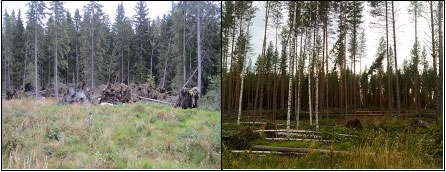
Figure JO-1. Under warming climate, the risk of wind damages in forests will increase regardless of any change in windiness.
Table JO-2. Mid- and long-term sensitivies of different tree species in the case study area. Legend: + increase, – reduction.
| Tree species | Growth | Mortality | Regeneration | |||
| 2020 -2050 | 2050-2100 | 2020 -2050 | 2050-2100 | 2020 -2050 | 2050-2100 | |
| Scots pine | +++ | ++ | + | + | +++ | ++ |
| Norway spruce | +++ | — | + | +++ | +++ | + |
| Birches | +++ | +++ | + | + | +++ | +++ |
Will the risk profile of tree species change under climate change?
Risk profile of different tree species will change along with warming climate in such a way that towards end of this century Norway spruce becomes more vulnerable than Scots pine and birch. High wind speeds and/or heavy snow loading accompanied with shorter duration of soil frost and, thus, reduced tree anchorage may increase the risk of damages regardless of tree species, but especially in Norway spruce with shallow rooting. Uprooted and/or broken trees are also suitable breeding material, e.g. for bark beetles, if not being harvested immediately. In addition, Norway spruce is expected to suffer drought the most and especially in the southern Finland on sites with relatively low water-holding capacity, making it also more vulnerable to insect outbreaks under warmer climate. On the other hand, if the share of Norway spruce may reduce opposite to Scots pine and birch in forests, the mortality of trees due to wind may in general decrease from late autumn to early spring (as birch is leafless) unlike in summer when Scots pine and birch are also vulnerable to wind damage (Figure JO-2).
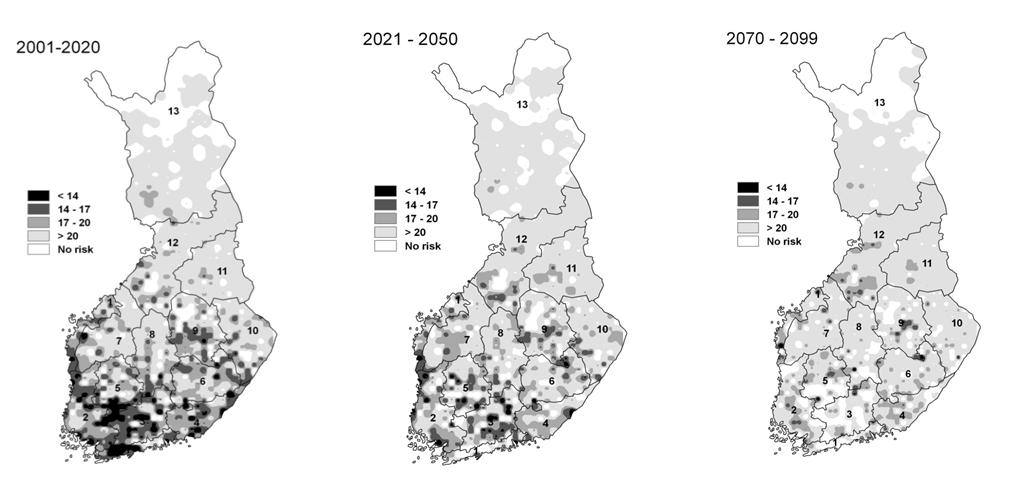
Figure JO-2. Predicted occurrence of different threshold (critical) wind speeds for uprooting of trees in Finland from late autumn to early spring towards end of this century (birch nor consider as being leafless). The decrease of share of lower critical wind speeds is related to possible decrease in the success and share of Norway spruce in tree species composition (opposite to birch and Scots pine), especially in southern Finland, due to increasing drought episodes increase. In the North, higher average dbh/h-ratio of trees and low share of Norway spruce explains the high resistance of forests to wind force. However, in summer the map would look different as in addition to Norway spruce also birch (in leaf) and Scots pine are vulnerable to damage.
Assume that current management (BAU) is continued: Is it possible to achieve current goals also under climate change conditions?
The main goal of management in the case study area is the sustainable and profitable use of the forest resources for all possible demands of society. This includes, in particular, the production of timber (for revenues), but also the maintenance of landscape beauty, attractive recreation environment including sustainable crops of berries and mushrooms, sequestration and storing carbon and providing habitats for wildlife. In short term (until the year 2020), a continuation of BAU will not affect the planned provisioning of ecosystem services (Table JO-3). In long term, the preference of Norway spruce on the sites of medium fertility (32% of forest area) or even on sites with lower fertility (44% of forest soils) due to moose problem in Scots pine and birch may reduce the capacity to produce timber and energy biomass, and sequestrate and store carbon in the ecosystem. This may also increase the risk of abiotic and biotic damages (e.g. bark beetle), which will further reduce the possibility to maintain the potentials to achieve the current goals under warming climate.
Table JO-3. Impacts of expected climate change on different forest ecosystem functions in the Finnish case study area. Legend: + positive impact, – negative impact, ~ indifferent.
| Forest ecosystem function | 2020 -2030 | 2050-2100 |
| Timber production | + | – |
| Carbon sequestration | + | – |
| Recreation values | + | ~ |
| Berries and mushrooms | + | ~ |
| Wildlife | + | ~ |
| Ground water | + | – |
| Landscape amenity | + | – |
Which adaptive measures appear as suitable response to the changing climate in order to sustain the provision of demanded ecosystem services? What is the recommendation to the forest management?
Table JO-4 summarizes some approaches available to adapt to the changing climate in short and long term. The case study area is located in the mid-boreal zone, where the warming is generally increasing the forest growth, if the availability of water is not reduced too much due to enhanced evaporation. In any case the changing climate is clearly increasing the frequency and duration of drought episodes, which occur even under the current conditions. Drought risk is likely reduced in northern boreal (and partly mid-boreal boreal) forests, but increased in southern boreal (and partly mid-boreal) forests, including the case study area.
In general, existing tree species (either native or exotic) are probably growing faster, with more rapid life cycle and enhanced turnover of tree populations. However, later in this century, the use of Norway spruce should be preferred only on the fertile and moist sites in order to avoid the likely reduction of growth and increase of drought caused mortality and damages due to bark beetles. The consequent reduction of area occupied by Norway spruce will reduce the wind-induced damages in winter. However, in summer time all tree species may suffer equally summer storms. Any increase in breeding material will increase the risk of damages due to bark beetle, due to a rapid growth of bark beetle populations (if not harvesting timber soon enough).
Regarding regeneration, the preference of coniferous species in planting may require careful site specific choice of tree provenance and species with more optimal response to the changing climate (Table JO-4). This seems to allow more southern and more productive provenances of Scots pine and Norway spruce to be used in forestry. However, the properties of photoperiod may limit the provenance transfers northwards to be less than 200 km even in short term. In long term, the tree improvement programmes may be launched in order to increase the genetic potentials of tree plantations to adapt to higher temperatures with low risk to be damaged by spring and autumn frosts. However, the preference of natural regeneration, and especially in Scots pine on less fertile sites (44% of forest soils in case study area), provides huge genetic potentials to adapt forest to the climate change in the region represented by the case study area. This choice is realistic, since natural regeneration is a common practise in forestry along with direct seeding in Scots pine.
Table JO-4. Outlines of the adaptive management for the boreal forests in Finland. Adopted and modified from Kellomäki and Leinonen (2005).
|
Changes in climate, with impacts on site properties |
Sensitivity and vulnerability |
|
|
|
|
|
Short term (2000 – 2050) |
Long term (2050 -2100) |
|
Management planning |
|
|
|
Gene management |
|
|
|
Forest protection |
|
|
|
Silvicultural management |
|
|
|
Technology and infrastructure |
|
|
Natural deciduous regrowth in coniferous plantations may require more tending of seedling stands in favour of coniferous species (Table JO-4). Later, more frequent and/or intensive thinnings may be needed to maintain the growth of trees and reduce risks of abiotic and biotic damages. The regular thinnings will also increase the stability of trees due to the enhanced radial growth, and thus reduce the risk of abiotic damages. Regular thinnings and shorter rotations are also needed to avoid biotic damages (e.g. due to lower growth rate of maturing trees and drought episodes), however, the need depending on the subarea of boreal zone and site fertility. Regular thinnings reduce the evaporation, thus increase soil moisture and reduce the risk of drought on the areas and soils, where the summer-time evaporation is likely to exceed the summer-time precipitation. In this regard, regular thinnings of Norway spruce stands may reduce substantially the effects of drought on growth and mortality.
How did you make your conclusion(s)? Which tools and methods did you employ?
The conclusions are mainly based on ecosystem model based analyses carried out in Finnish conditions. In these studies, the basic question has been: how is the climate change affecting the dynamics of managed boreal forest ecosystems and the consequent growth and development of managed boreal forests, and how the boreal forests should be managed under the climate change in order to sustain the production of goods and services obtainable in forest management. The main focus in these studies has been on the production of timber and biomass for energy and the sequestration and storing carbon in the forest ecosystem. However, also previous experimental studies on the climate change impacts (e.g. elevated CO2, temperature, availability of water and nitrogen) have provided data for modeling, which utilized the basic physiological mechanisms to introduce the climate change impacts into the dynamics of the forest ecosystems. On the other hand, some of these models (e.g. FinnFor/Sima models) include also the effects of management (e.g. regeneration, tending of seedling stands, thinning, rotation length, nitrogen fertilization, provenance effects on growth) on the structure and the consequent dynamics of the forest ecosystem. Large-scale and multiple applications of the models in scenario analyses and the analyses of the current functioning and structure of forests throughout Finland have given a comprehensive insight on how the managed boreal forests may growth and develop under changing climate change and how these changes should be considered in formulating management rule to fit the situation due the changing climate. The findings have been widely discussed also in seminars with other researches, forest practitioners, administrators and policy-makers. In this context, the future management options are scaled to meet the needs and possibilities set by economy, forest policy, legislation and perception among public.
How do you incorporate uncertainties in your recommendation?
Uncertainties are assessed by applying various climatic scenarios in order to find how the climate related uncertainties may affect the findings and conclusions. Some of the models include also stochastic processes of growth and mortality etc, to consider the uncertainties related to predictions. Regarding the risks due to wind and snow load, comprehensive assessments have also been done based on weather statistics to identify how frequent detrimental wind velocities and snow loads are and how they are expected to change due to the climate change.
Which obstacles are limiting the implementation of adaptive management?
Adaption of forests and forest ecosystems to the climate change can be improved by proper management. In fact, regular and timely management and harvest make it possible to modify the growing conditions and properties of tree populations and communities to allow easier adaption than that possible when excluding intentional management disturbances. Adaptation is nothing to occur in the future but actions are needed now in anticipation to the future conditions. In this regard, a major problem is that development and human acceptance of necessary actions is highly speculative and susceptible to uncertainties in the development of future climate. Furthermore, the future socio-economic context is unknown, with a need of adaptive forests policy, which is responsive to a wide variety of economic, social, political and environmental circumstance. This implies that the adaption is a long-term process from now onwards, including monitoring of stage of forest ecosystem and analysis of observations for planning and action in short-term time perspective (e.g. ten years) set by the management planning.
